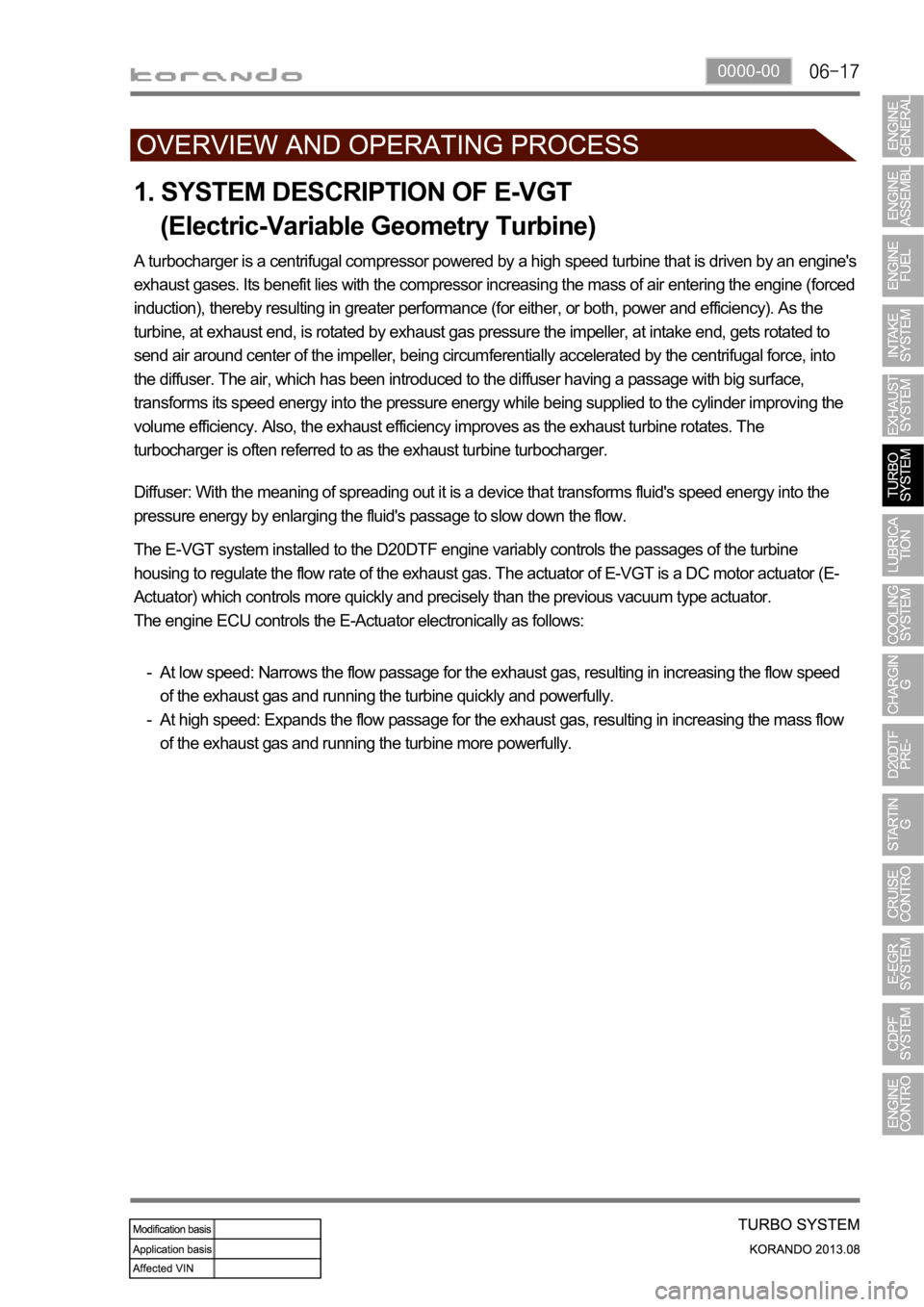Page 285 of 1336

0000-00
1. SYSTEM DESCRIPTION OF E-VGT
(Electric-Variable Geometry Turbine)
A turbocharger is a centrifugal compressor powered by a high speed turbine that is driven by an engine's
exhaust gases. Its benefit lies with the compressor increasing the mass of air entering the engine (forced
induction), thereby resulting in greater performance (for either, or both, power and efficiency). As the
turbine, at exhaust end, is rotated by exhaust gas pressure the impeller, at intake end, gets rotated to
send air around center of the impeller, being circumferentially accelerated by the centrifugal force, into
the diffuser. The air, which has been introduced to the diffuser having a passage with big surface,
transforms its speed energy into the pressure energy while being supplied to the cylinder improving the
volume efficiency. Also, the exhaust efficiency improves as the exhaust turbine rotates. The
turbocharger is often referred to as the exhaust turbine turbocharger.
The E-VGT system installed to the D20DTF engine variably controls the passages of the turbine
housing to regulate the flow rate of the exhaust gas. The actuator of E-VGT is a DC motor actuator (E-
Actuator) which controls more quickly and precisely than the previous vacuum type actuator.
The engine ECU controls the E-Actuator electronically as follows:
Diffuser: With the meaning of spreading out it is a device that transforms fluid's speed energy into the
pressure energy by enlarging the fluid's passage to slow down the flow.
At low speed: Narrows the flow passage for the exhaust gas, resulting in increasing the flow speed
of the exhaust gas and running the turbine quickly and powerfully.
At high speed: Expands the flow passage for the exhaust gas, resulting in increasing the mass flow
of the exhaust gas and running the turbine more powerfully. -
-
Page 309 of 1336

0000-00
2) Troubleshooting for Alternator
Item Cause Action
Overcharged battery Defective alternator voltage regulator Replace
defective alternator detection wiring Repair or replace
Discharged battery Loose alternator drive belt Adjust the belt tension or replace
Poor connection of related circuit or
open circuitRetighten the loose connection or
repair open circuit
Defective alternator voltage regulator Replace
Terminated battery Replace
Defective ground Repair
Charge warning lamp
does not come on when
turning on ignition switch
with engine stoppedDefective alternator voltage regulator Replace
Open circuit in charge warning lamp,
fuse or wiringReplace or repair the charge
warning lamp or fuse
Defective ignition switch Replace
Defective ground of alternator circuit Repair
Charge warning lamp
does not go off after
starting engineDefective alternator voltage regulator Replace
Corroded or worn battery cable Repair or replace
Loose alternator drive belt
Adjust the belt tension or replace the
belt
Defective wiring harness Repair or replace
Page 333 of 1336
2. TROUBLESHOOTING
ProblemAction
Engine will not crankLow battery voltage Charge or replace
Loose, corroded or damaged battery cable
Repair or replace
Faulty starter or open circuit
Faulty ignition switch or blown fuse Repair or replace
Poor engine ground Repair
Engine cranks too
slowLow battery voltage Charge or replace
Loose, corroded or damaged battery cable
Repair or replace
Faulty starter
Starter does not
stopFaulty starter
Faulty ignition switch Replace
Engine cranks
normally, but does
not startBroken pinion gear or faulty starter
Replace the starter
Broken flywheel ring gear Replace
Open circuit Repair
Page 528 of 1336
1452-01
2) Battery
Battery assembly
Clamp - Battery
Bolt
Cable assembly - Cable positive
Cable assembly - Battery ground
Bolt - Earth
Cap - Terminal
Connector - Battery 1.
2.
3.
5.
6.
8.
9.
10.Nut
Nut
Cab - Earth
Box assembly - Battery sub
Fuse - MID 80A
Clamp - Battery cable
Grommet - Ring terminal
Grommet - Ring terminal 17.
18.
20.
21.
22.
23.
24.
25.
Page 530 of 1336

1452-01
Troubleshooting
Item Cause Action
Overcharged batteryDefective alternator voltage regulator Replace
Defective voltage detection wiring Repair or replace
Discharged batteryLoose alternator drive belt
just the belt tension or
replace
Poor connection of related circuit or open
circuitRetighten the loose
connection or repair
open circuit
Defective alternator voltage regulator Replace
Terminated battery Replace
Defective ground Repair
Charge warning lamp does
not come on when turning on
ignition switch with engine
stoppedDefective alternator voltage regulator Replace
Open circuit in charge warning lamp, fuse
or wiringReplace or repair the
charge warning lamp or
fuse
Defective ignition switch Replace
Defective ground of alternator circuit Repair
Charge warning lamp does
not go off after starting
engineDefective alternator voltage regulator Replace
Corroded or worn battery cable Repair or replace
Loose alternator drive belt
Adjust the belt tension or
replace the belt
Defective wiring harness Repair or replace
Page 541 of 1336
1462-01
3. TROUBLESHOOTING
Problem Possible Cause Action
Engine will not
crankLow battery voltage Charge or replace
Loose, corroded or damaged battery cable
Repair or replace
Faulty starter or open circuit
Faulty ignition switch or blown fuse Repair or replace
Poor engine ground Repair
Engine cranks
too slowLow battery voltage Charge or replace
Loose, corroded or damaged battery cable
Repair or replace
Faulty starter
Starter does not
stopFaulty starter Repair or replace
Faulty ignition switch Replace
Engine cranks
normally, but
does not startBroken pinion gear or faulty starter Replace the starter
Broken flywheel ring gear Replace
Open circuit Repair
Page 578 of 1336
(2) Wiring Connection of CAN Communication
Splice pack Wiring Location
S101 Floor wiring (LH)Under fuse & relay box in engine
compartment
S102 Floor wiring (RH) Inside of right fender
S201 Main wiringBehind instrument cluster (cowl cross
member)
S202 Main wiringBehind instrument cluster (cowl cross
member)
S205 Floor wiring (LH)
Page 605 of 1336
0000-00
Inspection
Measure the current while removing the fuses one by one. If the current drops sharply when a certain
fuse is removed, inspect the affected circuit. 1.
Specified valuebelow 0.05A
6. INSPECTION - DARK CURRENT
Perform the basic inspection. -
Setting up the tester
Preparation
Disconnect the negative cable from the battery.
Set up the ammeter as shown in the figure above. 1.
2.
1) When Using Multi-tester